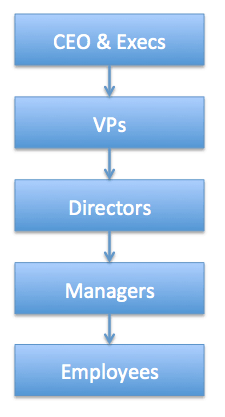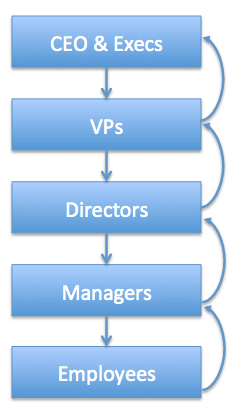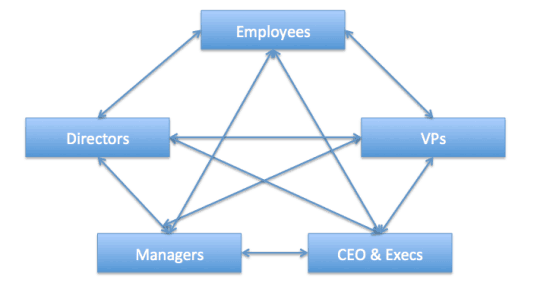People often talk about the need for senior leadership support for Lean. If we're going to really transform our culture, workplace, and performance, “quality starts in the boardroom,” as Dr. Deming said. Lean is not about “fixing” the employees — it's about changing the way we think and lead at all levels.
If executives and senior leaders embrace Lean thinking (and continuous learning and development), then they are better able to teach others and model the right behaviors (look at folks like Dr. Dean Gruner, Art Byrne, and others).
When the CEO “gets it,” it's very very helpful. Some say necessary.
But what if the CEO doesn't get it? What if other senior leaders don't get it?
There are those who don't get it and they don't care (or so it seems). They're unaware that they don't get it. They think they're fine and don't have much, if anything to learn. They are probably hopeless.
It's energizing and fun to work with senior leaders who “get it” – or at least they realize what they need to learn, what old habits need to change, and what they can do differently.
These new behaviors include embracing the idea of continuous learning. Early in my career, I had great examples of a few Lean leaders I idolized (leaders within companies) and they emphasized how much they still had to learn. I try to be the same way.
So How Do We Help Leaders Learn?
Let's assume first that they WANT to learn. I'm not sure you can make anybody want to learn (but you can probably try to expose them to examples and case studies that might pique their interest).
Executives will go to seminars. Some might attend webinars (although that's time consuming for a busy executive). Many executives like to read (that's why we wrote The Executive Guide to Healthcare Kaizen). Awareness and basic understanding – that's one aspect of learning.
You also need to TALK and DO. New knowledge might not really sink in until you have discussions with a coach or a group you trust. That's why many organizations do book clubs to read and discuss books like Lean Hospitals. As an aside, I sometimes participate, when invited, via conference call or Skype when a group invites me to their book club. I learn a lot in the process.
Talking about what you've read is really important. You need to practice articulating what you've learned. Do you really understand it? Can you build upon the ideas? Can you make it relevant to your local situation?
Does It Have to be Top Down?
I think people often have a model that the CEO and other senior leaders will understand all of this and then teach it to their VPs, who will then teach it to their directors, etc. That's one way, I guess.

That model is probably very slow. It also runs the risk of a game of “telephone” developing where the message gets diluted or changed. It also assumes perfect knowledge and understanding starting at the top. That might not be in place and it might not be possible, anyway.
The top-down teaching model probably works much better if there are “catchball” type discussion where the students push back and challenge things. It's probably quite likely that the VPs have something to teach the C-level executives, and so on.

That model still assumes, perhaps, a bit of top-down infallibility.
Maybe understanding comes from everybody learning, everybody discussing, and everybody teaching.

Is that more of a “learning organization?” Notice I put employees at the top (it was sort of a random distribution that breaks up the usual top down mindset).
I brought up this topic of helping executives learning (lamenting a very common gap that senior leaders sometimes know less about Lean than their employees do). Thanks to @twalk for his idea about employees teaching executives.
It's not at all uncommon that frontline staff have read more and understand #lean better than their managers and executives. Countermeasure?
— Mark Graban (@MarkGraban) August 16, 2014
@MarkGraban Leaders can hold reverse seminars: educate us.
— Tim Walker, traveling light (@TWalk) August 16, 2014
@TWalk That requires quite a bit of humility, eh?
— Mark Graban (@MarkGraban) August 16, 2014
@MarkGraban Oh, indeed. Imagine the good impacts on leaders (humility!) & team (KNOW their expertise is respected).
— Tim Walker, traveling light (@TWalk) August 16, 2014
@MarkGraban @respirologist Managerial humility. Visible Active Public CEO Commitment to transformation. Otherwise Brownian motion.
— Tim Delaney ⭐⭐ (@FrancosBruvva) August 16, 2014
What would happen if employees read a book and then taught their managers? What if the employees put together a seminar for executives?
There are many books on “managing up,” but what about “teaching up?”
Would most executives be humble enough to put themselves into that position? It would send a very positive message, eh?
Has anybody done this or seen this work well?
Reminder: I'm doing two free webinars in the next two weeks. Maybe you can view them with managers and leaders and facilitate discussions and learn together, if not help teach them:
- Thursday 8/21: “Getting Started with Continuous Improvement: Lessons and Reflections” (KaiNexus)
- Wednesday 8/27: “Practical Continuous Improvement Leadership: Coaching, Not Judging” (ThedaCare Center for Healthcare Value)
I hope you can make it!
Please scroll down (or click) to post a comment. Connect with me on LinkedIn.
Let’s work together to build a culture of continuous improvement and psychological safety. If you're a leader looking to create lasting change—not just projects—I help organizations:
- Engage people at all levels in sustainable improvement
- Shift from fear of mistakes to learning from them
- Apply Lean thinking in practical, people-centered ways
Interested in coaching or a keynote talk? Let’s start a conversation.










RE: The very common gap that senior leaders sometimes know less about Lean than their employees do.
I think that proves the assumption that leaders want to learn is incorrect (in most, but certainly not all cases).
A closed-mind is often the result of one’s success. Leaders deceive themselves into thinking they know more than they do. And they think knowing about something means they have the ability to do it and do it well.
In addition to not understanding Lean, they are prone to make many errors that undercut good lean efforts made by lower-level people.
It is a really tough problem, which is what attracted me to it 20 years ago. It is multi-faceted, and includes social, political, and economic factors that create distance between leaders and followers, and therefore makes it difficult (but not impossible) to “teach up.”
I believe this is relevant. In discussing lean and team learning, I’m often told, we learned that back ____ yrs ago. It may indeed be something they understand but do they really “know” and “model” the behavior of that understanding on a daily basis.
Bob hits a great point about success providing a disconnect between the realities of the necessity to keep learning by doing with lean principles. I’m working on implementing a co-mentoring program, where strong lean champions are partnered with the Senior Management team to grow our lean learning culture. The champions will partner with a Senior Manager outside of their function to help mentor and coach them on different aspects of the business, while the lean champions provide deeper reflection on lean learning by asking them lots of questions that pertain to a continuous improvement culture.
Our hope is a deeper level of learning on both parties as they stretch each other. A way to collaborate learning to some extent and we’ll follow the PDCA, with adjustment as necessary.
Thanks, Rick. There are opportunities for bi-directional mentoring and coaching in organizations. Senior management can mentor the lean champions, teaching them more about the business, etc. while the lean champions mentor the senior leaders about lean, challenging them, etc.
I’ve heard of companies using younger employees to mentor executives on technology, social media, etc. while the executives mentor in a “top down” way.
We all have something to learn from everybody, eh?
[…] Teaching Up in the Organization by Mark Graban. “If executives and senior leaders embrace Lean thinking (and continuous […]